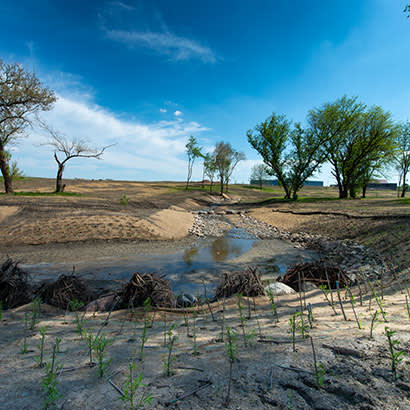
For an enhanced digital experience, read this story in the ezine.
In Story County, Iowa, an undevelopable wild area sat in the middle of a planned commercial development. The developer, Iowa State University’s Research Park, saw the potential for an amenity rather than an obstacle. What began as discussions between the research park and the county quickly grew into multi-agency conversations about a shared vision — a learning corridor that would provide a place where people could see first-hand how the urban-rural interface was not only possible, but also could improve the economy, environment and quality of life.
The Four Cs
The park’s namesake, Ted Tedesco, has been a stalwart of conservation and community betterment, serving as Ames mayor, on the Ames Planning and Zoning Commission, Ames City Council and Story County Conservation Board. Tedesco’s heart is in bringing people together and investing in future generations and our environment, and it was important these ideals were represented in the corridor. The “four Cs” concept coined by Tedesco would guide us through development: collaboration, cooperation, conservation and connectivity.
In order to create a space that embodied the four Cs, habitat restoration had to be a large part of the process. The landscape was greatly altered from its historic form; the stream was flashy, incised and disconnected from the floodplain, and invasive species had taken the place of pre-settlement wet meadow and upland prairie. We needed to do more than just repair the landscape. It had to become a live learning laboratory, modeling conservation techniques and sustainable technologies. And, because it was nestled in the heart of development, we had an opportunity to showcase stormwater management. Retention basins, which replicated wetlands, encouraged infiltration and also added aesthetically pleasing and functional habitat. Stream restoration work presented another opportunity to model up-and-coming sustainable strategies. Bioengineering techniques included using trees that had been removed during the prairie restoration to stabilize the banks. We strived to incorporate “greener” approaches to typical park amenities. Prairie reconstructed with local eco-type seed replaced traditional mowed turf grass. Repurposed shipping containers made perfect shelters. Filterpave — a new permeable surfacing material with recycled glass content — was used on secondary trails to further drive home a water-quality message. Interpretive panels throughout the park deliver messages about the value of these innovations and inspire others to think hard about habitat health.
The most recent Story County community health needs assessment identified physical activity and exercise as a priority. Therefore, making sure this venue is easily accessible for exercise and recreation was important. Situated on a bus route and located within city limits, the park is very accessible to residents. Upon arrival, visitors find a network of paved and mulched trails, boardwalks, and stream accesses and crossings to get them active and up close with nature. Connections to existing and future roads and trails ensure the park will remain stitched into the network of the surrounding communities as they grow.
Because the corridor is nestled between buildings where technology is developed and used, it is a prime candidate for technology-related amenities. Oftentimes, outdoor recreation is seen and promoted as an unplugged experience. But this space welcomes technology, creating an environment that all users can find comfort in. Solar-powered charging stations bring employees outside for meetings. Experiencing the park with a mobile device in hand doesn’t necessarily separate you from the resource; it can actually create better connections to fellow park users through social media and other digital experiences. And more technology is still being incorporated — future plans include incorporating citizen science time-lapse photography, allowing the community to take part in documenting the success of this new public space. An interactive touchscreen display inside the core facility of the research park will walk the user through restoration work and conservation practices. In the corridor, technology is bringing people together rather than separating them.
A Recipe for Success
The vision for the corridor was shaped through cooperation and collaboration among county, city, university and state partners, including the Research Park, Iowa State University, the Iowa Department of Transportation and the city of Ames. And, the positive feedback gathered in public meetings early on evolved into volunteerism and advocacy from multiple civic groups and individuals. Private donations complemented the grants and public dollars. A Kiwanis club has adopted the now-open park, doing trash pickup and other park beautification duties.
This living classroom provides a nexus between natural resource management, economic development and community well-being. Through coming together, we demonstrate synergy of environmental stewardship, healthy lifestyles, economic developments and water-quality improvements.
Erica L. Place is Outreach Coordinator for Story County Conservation.

